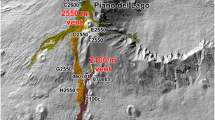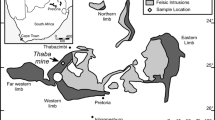Summary
Due to the slow equilibration rate of feldspar, its zoning pattern is likely to be of primary origin. Initial studies of zoning patterns of cumulus feldspar within the interval between the UG2 chromitite and the Merensky Reef have shown postcumulus growth to affect only the outermost rims of grains. Therefore, present-day grain sizes of plagioclase are considered to resemble the original cumulus grain sizes. A correlation between grain size of plagioclase and its composition and zoning pattern has been established: larger, complexly zoned grains correlate with more calcic compositions. It is inferred that the residence time of neutrally buoyant plagioclases within a periodically replenished host liquid determined their size and zoning pattern. Older and more calcic grains are larger and more complexly zoned, whereas finer grain sizes, which are associated with relatively primitive (Mg-rich) orthopyroxenes, are the result of partial resorption of plagioclase. Grain sizes of plagioclase, furthermore, show regional variation: grains are larger in the vicinity of Union Section than in the southeastern parts of the Western Bushveld Complex, which is interpreted as a consequence of the increasing distance from a putative feeder zone located near Union Section.
Zusammenfassung
Aufgrund der hohen Reaktionsträgheit von Feldspat ist dessen Zonierung höchstwahrscheinlich primärer Natur. Einführende Untersuchungen über Zonierungsmuster in Kumulus-Plagioklas im Interval zwischen der UG2 Chromitit-Lage und dem Merensky-Reef zeigten, daß Postkumulus-Wachstum nur den äußeren Rand der einzelnen Körner kennzeichnet. Demzufolge wird angenommen, daß die hier beobachteten Korngrößen den ursprünglichen Kumulus-Korngrößen entsprechen. Eine Korrelation zwischen der Korngröße von Plagioklasen und deren Chemismus und Zonierungs-muster konnte etabliert werden: größere, komplex zonierte Plagioklase haben einen höheren Anorthit-Gehalt. Diese Beziehung erklärt sich aus der relativ niedrigen Dichte von Plagioklas, die ein gravitatives Absinken verhindert. Demzufolge wurden Korngröße und Zonierungsmuster der in Schwebe befindlichen Plagioklase von der Verweildaner innerhalb einer sich periodisch ernenernden Schmelze bestimmt. Ältere, Ca-reiche Plagioklase sind relativ groß und komplex zoniert, während feinere Korngrößen, die zusammen mit relativ primitiven (Mg-reichen) Orthopyroxenen auftreten, das Ergebnis partieller Assimilation sind. Regionale Unterschiede existieren insofern, als daß Plagioklas in der Nähe einer postulierten Magmen-Zufuhrzone im Bereich von Union Section grobkörniger ist als in den südöstlichen Bereichen des westlichen Bushveld Komplexes.
Similar content being viewed by others
References
Abrams H (1971) Grain-size measurement by the intercept method. Mettalog 4: 59–78
Alling HL (1936) Interpretative petrology of the igneous rocks. McGraw-Hill, New York, p 353
Botha MJ (1987) Petrology and geochemistry of the lower group chromitites and host rocks on the farm Zandspruit 168 JP, Western Bushveld Complex. Thesis, Rhodes University, p 216
Bowen NL (1915) Crystallization differentiation in silicate liquids. Am J Sci 39: 175–191
Cameron EN (1969) Postcumulus changes in the Eastern Bushveld Complex. Am Min 54: 754–779
Covey-Crump SJ, Rutter EH (1989) Thermally induced grain growth of calcite marbles on Naxos Island, Greece. Contr Min Petr 101: 69–86
Eales HV, Field M, De Klerk WJ, Scoon RN (1988) Regional trends of chemical variation and thermal erosion in the Upper Critical Zone, Western Bushveld Complex. Min Mag 52: 63–79
Griffiths JC (1967) Scientific method in analysis of sediments. McGraw-Hill, New York, p 508
Hunter RH (1987) Textural equilibrium in layered igneous rocks, 473–503. In:Parsons I (ed) Origins of igneous layering. Reidel, Dordrecht Boston Lancaster Tokyo, p 666
Irvine TN (1974) Petrology of the Duke Island Ultramafic Complex, Southeastern Alaska. Geol Soc Am Mem 138, p 240
Jackson ED (1961) Primary textures and minerai associations in the ultrarnafic zone of the Stillwater Complex. Montana Geol Surv Prof Pap 358, p 106
Kruger FJ (1982) The petrology of the Merensky Cyclic Unit and associated rocks and their significance in the evolution of the Western Bushveld Complex. Thesis, Rhodes University, p 123
Krumbein WC (1935) Thin sectional mechanical analysis of indurated sediments. J Geol 43: 482–496
—— (1938) Manual of sedimentary petrography. D. Appleton-Century, New York London, p 549
Lee CA, Sharpe MR (1980) Further examples of silicate liquid immiscibility and spherical aggregation in the Bushveld Complex. Earth Plan Sec Lett 48: 131–147
Maaløe S (1976) The zoned plagioclase of the Skaergaard Intrusion, East Greenland. J Petrol 17: 398–419
Maier WD (1992) Geochemical and petrological trends in the UG2-Merensky Unit interval of the Upper Critical Zone in the Western Bushveld Complex. Thesis, Rhodes University, p 253
Marsh BD (1988) Crystal capture, sorting, and retention in convecting magma. Geol Soc Am Bull 100: 1720–1737
—— (1989) On convective style and vigor in sheet-like magma chambers. J Petrol 30: 479–530
McDonald JA (1967) Evolution of part of the Lower Critical Zone, Farm Ruighoek, Western Bushveld. J Petrol 8: 165–209
Morse SA (1986) Convection in aid of adcumulus growth. J Petrol 27: 1183–1214
Reynolds IM (1979) Grain boundary relationships in some Bushveld titaniferous magnetite cumulates. Geol Soc S Afr, 18th Congr Proc, pp 297–299
Smith CS, Guttman L (1953) Measurement of intcrnal boundaries in three dimensional structures by random sectioning. Trans AIME 197: 81–87
Teigler B (1990) Mineralogy, petrology and geochemistry of the Lower and Lower Critical Zones, Northwestern Bushveld Complex. Thesis, Rhodes University, p 247
—— (1992) The cumulate succession in the Critical Zone of the Rustenburg Layered Suite at Brits, Western Bushveld Complex. S Afr J Geol 95: 17–28
Thompson AW (1972) Calculation of truc volume grain diameter. Mettalog 5: 366–369
Vermaak CF (1976) The Merensky Reef-thoughts on its environment and genesis. Econ Geol 71: 1270–1298
Author information
Authors and Affiliations
Additional information
With 9 Figures
Rights and permissions
About this article
Cite this article
Maier, W.D. Grain-size variations of cumulus plagioclase in the upper critical zone of the Bushveld Complex. Mineralogy and Petrology 50, 245–258 (1994). https://doi.org/10.1007/BF01164608
Received:
Accepted:
Issue Date:
DOI: https://doi.org/10.1007/BF01164608




